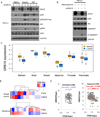Phosphoproteomic analysis identifies Grb10 as an mTORC1 substrate that negatively regulates insulin signaling
- PMID: 21659605
- PMCID: PMC3195509
- DOI: 10.1126/science.1199484
Phosphoproteomic analysis identifies Grb10 as an mTORC1 substrate that negatively regulates insulin signaling
Abstract
The evolutionarily conserved serine-threonine kinase mammalian target of rapamycin (mTOR) plays a critical role in regulating many pathophysiological processes. Functional characterization of the mTOR signaling pathways, however, has been hampered by the paucity of known substrates. We used large-scale quantitative phosphoproteomics experiments to define the signaling networks downstream of mTORC1 and mTORC2. Characterization of one mTORC1 substrate, the growth factor receptor-bound protein 10 (Grb10), showed that mTORC1-mediated phosphorylation stabilized Grb10, leading to feedback inhibition of the phosphatidylinositol 3-kinase (PI3K) and extracellular signal-regulated, mitogen-activated protein kinase (ERK-MAPK) pathways. Grb10 expression is frequently down-regulated in various cancers, and loss of Grb10 and loss of the well-established tumor suppressor phosphatase PTEN appear to be mutually exclusive events, suggesting that Grb10 might be a tumor suppressor regulated by mTORC1.
Figures




Comment in
-
Cell signaling. New mTOR targets Grb attention.Science. 2011 Jun 10;332(6035):1270-1. doi: 10.1126/science.1208071. Science. 2011. PMID: 21659593 No abstract available.
References
Publication types
MeSH terms
Substances
Grants and funding
LinkOut - more resources
Full Text Sources
Other Literature Sources
Medical
Molecular Biology Databases
Research Materials
Miscellaneous

